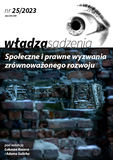Information for the Authors
As the journal has been founded with the intent to contribute to development of sociology of politics, increasing the scope of sociological reflection and writing on the political is our main objective. That is why we expect:
- theoretical papers, presenting conceptual apparatus explaining changes in the sphere of the political;
- empirical analyses, both qualitative and quantitative concerning the phenomenon of the political;
- methodological approaches concerning specific nature of political research;
- review of newest publications crucial for the field of the political.
We invite papers representing sociology, psychology, socio-biology, anthropology, ethnography, management, social psychology, demography, philosophy, political science and others.
General guidelines
- Manuscripts should not contain previously published materials and must not be under consideration for publication elsewhere.
- They should be prepared and sent in text formats with extensions as doc, docx, rtf.
- All pictures, graphics, photos or other illustrations included in the papers should be also attached as a separate file (saved in the following formats: JPEG, TIF, GIF, BMP)
- We would like the Authors to include their name /s without institutional affiliation and titles
- Manuscripts should be accompanied by the statement confirming Author/s ‘exclusive legal rights for the text, must state that the material for which the authors have exclusive rights is original and has not been submitted for publication elsewhere (including websites). In order to prevent the practice of ghostwriting and guest authorship, the letter must also include a statement attesting and indicating the specific contribution each author made to the manuscript.
- Manuscripts are to be sent to email address of wladzasadzenia@gmail.com, together with short biographical information on Author/s, including name, occupation, institutional affiliation, position, title , e-mail address , interests and main publications.
- The statements should be signed, scanned and sent to our e-mail address or printed, signed and sent to our postal address.
“Power of Judgment” Editorial Board
Department of Sociology of Politics and Morality
Institute of Sociology University of Lodz
Ul. Rewolucji 1905r. 41/43
90-214 Lodz, Poland
General construction of the paper
- The paper should include minimum 6 pages (aprox. 9000 signs without spaces), type 11/12, with standard margin and line spacing 1.5.
- It should include the title, summary and key words in both Polish and English.
- The text should have clear structure. Its content should include introduction, argumentation and conclusion.
- Quotations should be given in italics, without quotation marks, preceded by bracketed suspension points (…).
- Foreign-words used in the text should be italicized.
- Titles of books, articles, films, TV shows, radio broadcasts or conferences should be quoted in italics.
- Titles of newspapers or magazines quoted in the paper should be given in inverted commas (as “The Times”, “Qualitative Sociology Review”).
- We kindly ask authors to submit only carefully prepared manuscripts that are adjusted to these requirements. Grammar or spelling mistakes, wrong text formatting might result in sending them back to the author/s.
References, footnotes and endnotes
- Please apply footnotes only to apply extra information, or author’s comments.
- References are to be included in the body of the text, according to the APA 6th Edition (American Psychological Association) rules:
- standardnotationinclude: (Foucault, 2004), in the caseindicate the number ofpages(Foucault, 2004, p.35), and the range of pages(Foucault, 2004, pp.11-15);
- if the name of quoted author is included in the text, please add the year of publication, e. g. […] (2004);
- in the case ofthe corporate author (Cambridge University, 2013);
- when the text refers to has two authors: (Berger and Luckmann, 2010, pp.55-59);
- when three authors are quoted/referred to, the first reference note should include all of them e. g. (Beck, Giddens, Lash 2009), and the next only the first name with” et. al.” e.g. (Beck et al. 2009). All names should be included in the bibliography;
- in case of referring to more authors their bibliographic data should be presented in chronological order and separated by semicolon , e. g. (Chomsky 1982; Foucault 1998; Giddens 2006);
- when referring to the source having been quoted in another source (indirect quotation), the name of the primary author and the date of his/her publication and page number should be put on the first place, and the secondary source quoting the primary one should be following it, e. g. (Eisenstadt, 1956, p.78, qtd in Griese, 1996, p.134). Bibliography should contain only the secondary source;
- referring one text of the same author several times, please always refer to his/her name and publication’s date;
- for quotingseveral works bythe same authorpublished inthe same yearshould bedistinguishedby the addition ofsuccessiveletters of the alphabet(no spaces) to the year, such as: (Giddens, 2006a), and in another place (Giddens, 2006b);
- in case of unpublished manuscripts, please add “in print”, or indicate its form, as “hard copy”.
Bibliography
- References shouldbe placedat theend of the text. The formshould be consistentwith the standardAPA6th Edition. Allpublicationscited by theauthor /authorshouldbelisted in alphabetical order. The first elementof the description shouldbethe author’s name, followed bythe decimalinitial/sname/names,year of publication inparentheses, after the dotjob titlein italics,after the dotplace of publicationandpublisher nameafter the colon:
- Mannheim, K. (1952). Essays in the Sociology of Knowledge. London: Routledge.;
- Berger, P. L., Luckmann, T. (2010). The Social Construction of Reality. Warszawa: PWN.
- To refer to two or more texts of one author, published in the same year, indicated by letters put after the date, their titles should be put in alphabetical order.
- Bibliographic description of collected works should be organized as follows:
- Wodak, R., Krzyżanowski, M. (ed.). (2008). Qualitative Discourse Analysis in the Social Sciences.New York: Palgrave Macmilan.
- Bibliographic description of chapter in collected works should be organised as follows:
- Reisigl, M. (2008). Analyzing Political Rhetoric. In: R. Wodak, M. Krzyżanowski (ed.), Qualitative Discourse Analysis in the Social Sciences (pp. 151-183). New York: Palgrave Macmilan.
- Bibliographic description of an article in the print journal / newspaper should be organized as follows(if the article has a DOI serve it at the end):
- Lacquement, G. (2013). Involvement of local stakeholders in LEADER (2007-2013) programme partnerships in Eastern Germany: network thinking and context effects, Folia Sociologica, 44/2013, 55-72, DOI: 11089/3187
- Bremmer, I. (2014). A Tortured Policy Toward Russia, New York Times, 27 March 2014, A31
- If the textis on theweb siteand is notin ajournalarticle, book,orchapterin the book, the description should havethe following form:
- Hoffer, F. (2014), The Real Problems of Migration And Work And How To Solve Them, Downloaded from: social-europe.eu/2014/04/migration-and-work
- Unpublished manuscripts description should be organised as follows:
- Glaser, B. (2005). The World-Wide Adoption of Grounded Theory. Paper presented during the 37th World Congress of the IIS, July 6, Stockholm, Sweden.

